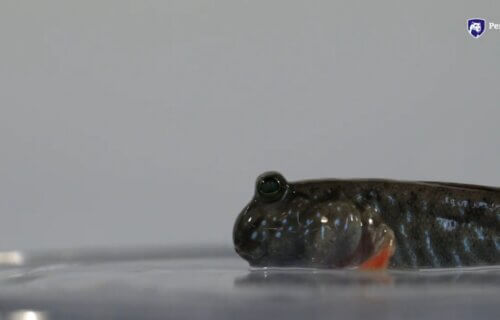UNIVERSITY PARK, Pa. — A blinking fish has revealed how our aquatic ancestors first ventured onto land approximately 375 million years ago. These ancestors evolved into tetrapods, which include today’s amphibians, reptiles, birds, and mammals. The mystery of their survival in terrestrial environments has puzzled scientists for decades.
A recent study found that the key to understanding this transition lies in the humble mudskipper — a species of fish that uses its pectoral fins like legs to walk and even climb trees. The mudskipper lives both in and out of water, forages for food on the ground, and blinks, much like humans do.
“The mudskipper, which evolved its blinking behavior independently, provides an opportunity to examine how and why blinking may have evolved in a living fish that regularly leaves the water to spend time on land,” says study lead author Dr. Thomas Stewart from Penn State University.
Humans blink around 13,500 times a day to clean our eyeballs and facilitate communication, with rates increasing during conversation. The mudskipper’s blink lasts about the same length of time, and its eyes bulge out of the top of its head, similar to a frog’s. The fish briefly retracts its eyes into sockets where they are covered by a stretchy membrane called a “dermal cup.”
“This demonstrates that a rudimentary system can be repurposed to perform a complex behavior without requiring the evolution of many new components,” explains co-author Dr. Brett Aiello from Seton Hill University in a media release.

This fish doesn’t need tears to cure dry eyes
In humans, tears are essential for keeping eye cells healthy and oxygenated. Aiello found that, like humans, mudskippers blink more frequently when faced with dry eyes. Remarkably, they can wet their eyes through blinking even without tear glands or ducts. Instead of relying on glands around the eyes and on the eyelids like humans, mudskippers appear to mix mucus from their skin with water from their surroundings to produce a tear film.
“Having the opportunity to study how and why this behavior first evolved provides an incredible opportunity to learn more about human evolution and the changes associated with major transitions in animal history, such as inhabiting land,” says Aiello, noting the importance of studying this transition for understanding human evolution.
Blinking is a subtle yet complex action that humans and other tetrapods constantly perform throughout the day, often without even noticing. This action is critical to the health and safety of the vertebrate eye. According to Stewart, the transition to life on land required numerous anatomical changes, including those related to feeding, locomotion, and breathing air.
“Based on the fact that mudskipper blinking serves many of the same functions as blinking in our own lineage, it is likely that blinking was part of the suite of traits that evolved as tetrapods adapted to live on land,” the researcher concludes.
These quotes emphasize the value of studying the mudskipper in order to better understand the evolution of blinking and the adaptations that allowed our aquatic ancestors to transition to life on land.
The findings appear in the journal Proceedings of the National Academy of Sciences.
South West News Service writer Mark Waghorn contributed to this report.


Can you and I add DNA or change our DNA within ourselves by thinking hard enough about it? Go ahead and try. Do you think that this fish can do it? Hmmm….. Well, if it needed to survive could it reason enough to change itself quickly enough before it was eaten? The answer is obvious. If the DNA for higher life forms is not currently present in any living organism – then no such thing will come into existence. No living thing can think it’s way to fundamentally change. This is the big problem with the “Theory” of Evolution. If all life started with a single cell creature like an amoeba, where is the existence of any DNA within itself for anything higher than it? Where did Aristotle, Michaelangelo, Beethoven, Madam Curie, Albert Einstein, a Girl who can flip on the Balance Beam come from? Out of a single cell organism? Not likely.
The Lord God made them all for His pleasure and ours. In the beginning God…
ONLY the anti-God crowd promotes such blather. The FACT is that carbon dating is STILL a theory, so 375 million years ago is just someone’s theory, perhaps trying to sell their latest book on the subject.